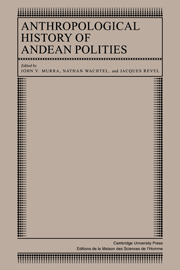Book contents
- Frontmatter
- Contents
- List of contributors
- Preface
- Introduction
- Part I Ecology and society
- Part II The ethnic group and the state
- Part III Systems of classification
- Part IV Symbolic representations and practices
- Part V From ethnic polities to communities
- 15 Men of the water: the Uru problem (sixteenth and seventeenth centuries)
- 16 The ethnic groups in the valleys of Larecaja: from descent to residence
- 17 The Andean community today
- Bibliography of published source
- Index
16 - The ethnic groups in the valleys of Larecaja: from descent to residence
Published online by Cambridge University Press: 05 October 2010
- Frontmatter
- Contents
- List of contributors
- Preface
- Introduction
- Part I Ecology and society
- Part II The ethnic group and the state
- Part III Systems of classification
- Part IV Symbolic representations and practices
- Part V From ethnic polities to communities
- 15 Men of the water: the Uru problem (sixteenth and seventeenth centuries)
- 16 The ethnic groups in the valleys of Larecaja: from descent to residence
- 17 The Andean community today
- Bibliography of published source
- Index
Summary
It takes a day's journey to reach the valleys of Larecaja from Lake Titicaca. Starting from its eastern shores (at 3, 800 meters), one climbs several hundred meters higher to reach the crests (between 4, 100 and 4, 600 meters) and crosses the punas. The descent of the first slope follows, and from 3, 600 to 2, 700 meters one finds the level spots to which the towns cling.
These two ecological zones (the hills surrounding the lake, and the upper valleys) are stepped and near each other. They supply the complementary agricultural products indispensable for human life. Wool and charqui come from above; also fish, many varieties of tubers and legumes; other varieties of the very same crops come from below, along with maize. This complementarity has allowed the peasants to achieve simultaneous access even today: This happens because communities either maintain their own lands both above and below or obtain them through links of alliance between households on the two tiers. Even today, communities in the puna still maintain their rights in the valladas, some of them very far away; some achieve this communally (like the Macha, in northern Potosi) or as individuals, as do some of the Quillaca, from Lake Poopó.
Such complementarity can no longer be found in Larecaja: if the exchange of produce from the altiplano and the valleys takes place in contemporary markets, this occurs as barter or for money. The participants have forgotten any past kin ties or common origin.
- Type
- Chapter
- Information
- Anthropological History of Andean Polities , pp. 311 - 341Publisher: Cambridge University PressPrint publication year: 1986
- 36
- Cited by



